At the Natural Health Society, we have promoted eating an abundance of fruit and vegetables for the past 60 years. Here is an article by our Health Director and Editor, Roger French, on the wonderful benefits of vegetables. This article is as relevant today as it was a decade ago when we published it in our magazine True Natural Health.

Food for Feeling Great – Fresh Vegetables
Fresh vegetables are essentially cocktails of minerals, vitamins, other antioxidants, fibre and thousands of phytochemicals, all in a very high content of water. The water content ranges from approximately 86% in beetroot to approximately 95% in cucumber, lettuce, Chinese cabbage, celery and tomato.
In spite of this high water content, the fresh vegetables are regarded as ‘nutrient dense’ foods – meaning that the mineral, vitamin and phytochemical content is very high in comparison to the number of calories. Vegetables yield very few calories because they contain insignificant levels of protein, carbohydrate and fat. We can safely and very beneficially eat a lot of veggies.
The Natural Health guideline is to consume approximately 350 to 700 grams or more of fresh vegetables daily – as part of a total intake of vegetables and fruits daily of around 1,000 to 1,250 gm or more, depending on the size of the adult. The ideal is to have one or two large, raw vegetable salads every day. Or have a raw veggie salad as the basis of one meal and lightly steamed veggies as the basis of another. The third meal would be based on fruit.
All fresh vegetables are highly alkali-forming, due to their very high content of potassium and modest levels of magnesium and calcium. The acid fruit-vegetable, tomato, although containing significant organic acids, is also alkali-forming. (You can test your body’s acid/alkali balance using these test strips available through our online store.)
NOTE that quantities of food constituents vary among individual foods due to differences in climate, soil fertility, the tests used and so on. It is only possible to give approximate figures.
LEAF VEGETABLES
Lettuce
There are many varieties of lettuce, common ones being Iceberg (or Imperial), Cos, Mignonette (green and red), Butterhead, Coral and Oakleaf.
As with other leafy veggies, the darker green the leaves, the more nutrients present. For example, Cos lettuce contains much more beta-carotene, calcium and potassium than Iceberg. It is a good idea to mix a variety of greens in any salad so as to enhance the range of nutrients.
The very palatable lettuce contains an abundance of nutrients. The green chlorophyll is good for blood, brain and nerves. There is a good level of vitamin K essential for blood clotting. An exceptional level of silicon promotes growth of hair and skin. The key alkaline mineral, potassium is abundant. The carotenoids, beta-carotene, lutein and zeaxanthin are at good levels, the last two being essential for the prevention of macular degeneration. There is also a significant quantity of folate (vitamin B9), which is essential for the prevention of anaemia, spina bifida and heart disease.
A compound called lactucarium in lettuce has a subtle sedative effect.
Lettuce – which has the advantage of not needing cooking – is an excellent all-round veggie and has a place in every salad.
Silverbeet and Spinach

Silverbeet and spinach are distant cousins, both being dark green and exceptionally rich in minerals and vitamins and no doubt an abundance of phytonutrients. Silverbeet, also known as Swiss chard, is what most of us refer to as ‘spinach’ in Australia. True spinach is English spinach.
The great assets of these two veggies are chlorophyll, potassium, iron and folic acid. For most nutrients, English spinach contains much higher levels than silverbeet. Respectively for English spinach and silverbeet, the levels per 100 grams are: potassium 570 mg and 260 mg; iron 3.2 mg and 2.3 mg; folic acid 150 micrograms for both. These are high levels of the invaluable folic acid.
Silverbeet alone contains exceptionally high levels of organic sodium, as distinct from inorganic table salt sodium.
The chlorophyll cleanses the blood and supplies magnesium. These levels of iron are equivalent to those in red meat, which is remarkable for a bulky vegetable. Oxalic acid is often regarded as a problem in these veggies, but if the spinach or silverbeet are raw, the effect on iron is insignificant, so they are very good sources of iron. When these veggies are cooked, the oxalic acid can then be detrimental. Oxalic acid has beneficial effects itself – it is a constituent of blood and is required by the immune system.
Both veggies are very rich in beta-carotene, lutein and zeaxanthin, the levels being much higher than in lettuce, so the protective effect on the eyes alone could be very great. Vitamin K is also at very high levels, as is fibre.
Spinach and silverbeet are easily eaten raw chopped into a tossed salad or as part of a veggie juice.
Parsley
This is a potent, super-nutritious herb that should be eaten only in small quantities, especially during pregnancy, or avoided altogether if there is kidney inflammation. Parsley is a case of a little is really good, a lot isn’t.
Parsley is fairly loaded with potassium (900 mg per 100 gm food), calcium (200 mg), iron (9 mg), zinc (1.1 mg), vitamin C (100 mg) and carotenoids. Also well above average are magnesium and B-vitamins. And, of course, plenty of chlorophyll.
Along with helping to prevent nasty degenerative diseases, parsley is said to assist the body to eliminate excess sodium from common salt. And partly due to its phenomenal potassium content, it is particularly useful for reducing high blood pressure.
Add a small amount of parsley to salads, use tabouli, or best of all include in veggie juices.
Dandelion leaves
This ‘weed’ that grows in our gardens is actually very good nutrition. It offers the usual health benefits of a green veggie and is also high in iron and copper. It is a liver tonic and stimulant to the gallbladder and helps prevent gallstones.
A leaf or two could be chopped into a salad or incorporated into a veggie juice.
CRUCIFEROUS VEGETABLES – BRASSICAS
Brassica vegetables are members of a genus in the Cruciferous family. The famously healthy and cancer-fighting Brassicas include broccoli, cauliflower, cabbage, Chinese cabbage, bok choy, Brussels sprouts, kohlrabi, rocket, turnip and mustard greens.
and collard greens (collard is an uncommon vegetable).
The great ‘asset’ of these vegetables is anti-cancer effects. They supply antioxidants, inactivate cancer-causing toxins, inhibit the growth of cancerous tumours and cause cancer cells to self-destruct. They contain unique phytochemicals called glucosinolates, which convert in the body to potent anti-carcinogens, including sulforaphane – but only if the veggie is eaten raw, because the converting enzyme is inactivated by cooking. A New York study found that as little as three servings a month of raw broccoli, cauliflower or cabbage reduced the risk of bladder cancer by about 40%. Because there was no similar effect from other vegetables or from cooked Brassicas, it was evident that the anti-cancer factor was uniquely in Brassica vegetables and was destroyed by cooking. Most kinds of cancer would be benefitted by these veggies.
Sulforaphane is able to destroy the Helicobacter pylori bacterium which is associated with stomach ulcers. The juices of these veggies can be very helpful with these ulcers.
However, some glucosinolates have anti-thyroid effects, referred to as ‘goitrogenic’. They make it more difficult for the thyroid gland it to absorb iodine and so inhibit thyroid function. If the intake of Brassicas is modest, this effect can be countered by getting enough iodine in the diet (such as from sea kelp). However, large amounts of some glucosinolates will suppress the thyroid regardless of the intake of iodine. Obviously some degree of balance is needed.
Broccoli
Broccoli contains a fistful of nutrients and beneficial phytochemicals. It is particularly rich in glucosinolates that convert to sulforaphane, making it one of the most cancer-protective of all foods. This quality is backed up by valuable levels of the antioxidants, carotenoids and vitamin C, and also folate. There is a lot of potassium and good levels of calcium, magnesium and iron. Broccoli contains significant amounts of lutein and zeaxanthin, which protect the eyes from macular degeneration.
As vegetables go, broccoli is high in protein at almost 5%.
The lignans in broccoli mitigate oestrogen, and so tend to protect against breast cancer and other oestrogen-dependant cancers.
Best eaten raw or only very lightly steamed, broccoli is an outstanding all-round veggie that is strongly alkali-forming and strongly anti-cancer and ‘anti’ many other degenerative diseases. In fact, it is ranked by the US National Cancer Institute as the top all-round anti-cancer vegetable.
Cabbage
 The common varieties of cabbage are green, red, Savoy, Chinese, bok choy and Brussels sprouts (a lot of small cabbages).
The common varieties of cabbage are green, red, Savoy, Chinese, bok choy and Brussels sprouts (a lot of small cabbages).
Although overshadowed by broccoli, cabbage is strongly anti-cancer for the same reasons. Along with sulforaphane, it is rich in chlorine, both of which cleanse the blood and enhance liver function. Cabbage juice has long been used as therapy for stomach ulcers with great success, which we now know is largely due to sulforaphane destroying Helicobacter pylori.
Mineral content is similar to broccoli, as is a rich folate level. Carotenoids are only one tenth and vitamin C level is less than half.
Red cabbage is rich in the very powerful antioxidants, anthocyanins, a 100-gram raw serving providing 28 mg of anthocyanins. Green cabbage pales into insignificance against red in this regard.
Eat cabbage uncooked as coleslaw or finely chopped as part of a fresh salad. Lightly cooked cabbage rolls is another popular option. Cook this veggie too much and out comes the sulphur – and it stinks!
Cauliflower
Like cabbage, cauliflower is abundant in sulforaphane and chlorine, and so provides their cleansing and anti-cancer benefits. Vitamin C and folate are also similar, making this another highly nutritious veggie. Mineral levels are mediocre, except for potassium, which is right up there with broccoli.
Cauli can be eaten raw in a salad if it is finely chopped. Otherwise steam it lightly or have it topped with cheese and baked – cauliflower au gratin.
Brussels sprouts
Named after the capital of Belgium, Brussels sprouts is the richest Brassica in folate (135 micrograms) and also abundant in sulforaphane, giving it similar valuable anti-cancer properties. Mineral content broadly matches those of broccoli and cabbage.
Brussels sprouts can be eaten like cauli – raw in a salad finely chopped, otherwise lightly steamed.
Kale
Kale is a leafy Brassica and highly nutritious. The various varieties have frilly leaves and range in colour from grey/blue to purple/green.
Compared to other green leafy vegetables, even broccoli or silverbeet, the nutrient profile of kale is exceptional. It is a great source of chlorophyll, calcium, iron, vitamin C and carotenoids. It is also one of the most abundant plant sources of sulphur, which promotes detoxification by the liver and is an excellent blood purifier with antiseptic effects for the digestive tract. Its juice can be used to treat stomach and duodenal ulcers.
Cooking destroys sulphur so including some chopped raw leaves in a salad is a good idea. Nevertheless, including kale in a stir-fry is better than missing out altogether on this nutritional star.
Kale is richer in vitamin K than almost any other food.
Kale’s nutrient richness stands out in three particular areas:
(1) Antioxidant nutrients, mainly the carotenoids beta-carotene and lutein, and the flavonoids quercetin and kaempferol.
(2) Anti-inflammatory nutrients, in particular the omega-3 fatty acid alpha-linolenic acid (ALA). 100 gm kale provides one third of the day’s needs of omega-3.
(3) Anti-cancer nutrients in the form of glucosinolates, of which kale is a top food source. Studies show kale has cancer preventive benefits and in some cases treatment benefits as well for cancers of the colon, breast, prostate, bladder and ovaries.
Rocket
This short leafy Brassica has a hot, peppery flavour. Native to the Mediterranean region, it is also known as rocket lettuce, rocket salad, eruca and arugula.
Rocket contains many valuable antioxidants, vitamins, minerals and phytochemicals. The strong flavour of rocket is due to its antioxidants. Like the other Brassicas, it is rich in sulforaphane and also folate. Rocket is rich in carotenoids and vitamin-K and has good levels of B-vitamins and the minerals potassium, iron, calcium and magnesium.
This is another excellent veggie to include frequently in fresh, raw salads.
Kohlrabi
Kohlrabi means ‘cabbage turnip’ in German.
It has numerous health benefits. Kohlrabi is exceptionally high in vitamin C, which promotes a strong immune system, improves iron absorption and helps regenerate vitamin E. It is also abundant in potassium.
Kohlrabi is an excellent source of fibre, and so feeds the good bacteria and helps prevent constipation.
It can be eaten raw, grilled or stir-fried.
FRUIT VEGETABLES
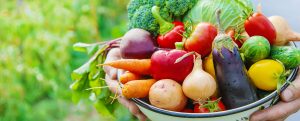
Tomato
One of the most popular of the veggies, having juiciness (it’s 95% water), flavour and appealing colour. The tomato is eaten raw, cooked, sun-dried or canned.
Tomato is actually an acid fruit, due to a significant content of citric, oxalic and malic acids (giving pH 4.2). Nevertheless, like virtually all fresh fruits and veggies, it actually alkalises the tissue fluids and helps neutralise the acidity underlying arthritis, rheumatism and many other conditions.
The greatest attribute of the tomato is that it is one of the richest of all foods in the powerful antioxidant, lycopene, one of the 600-odd carotenoids. Studies have found that tomatoes among all foods bring about the most dramatic reduction in the risk of prostate cancer, with regular consumption decreasing the risk by 40 percent. Because lycopene is so effective at mopping up free radicals, most cancers are benefitted, especially those of the digestive tract, breasts and lungs. In relation to heart attack, a high intake of lycopene can halve the risk.
A high intake has also been found to enhance mental and physical capacity in older people, making the tomato an excellent food for all ages.
A top-of-the-class level of chlorine in tomatoes stimulates elimination by the liver, facilitates stomach hydrochloric acid production and assists in achieving proper fluid balance.
Apart from the exceptional levels of lycopene and chlorine, other minerals and vitamins are at mediocre levels.
Cucumber
‘Cool as a cucumber’ is mainly due to a very high water content (95 – 96%) and lack of any stimulating constituents. It really is a good food for hot days.
Like the tomato, the cucumber has mediocre levels of minerals and vitamins, but with a few striking exceptions – high levels of silicon, chlorine and sulphur. Along with lettuce, cucumber is one of the very few foods that are rich in silicon, a mineral that gives strength to bones and nails, and promotes hair growth and healthy skin. Unfortunately, peeling the cucumber removes most of the silicon.
The chlorine promotes skin health, as well as cleansing the blood and facilitating hydrochloric acid production in the stomach for protein digestion. The sulphur further enhances the skin – a cucumber facial is well-founded.
Being a diuretic, cucumber can help ease high blood pressure and rheumatic pain.
Capsicum
This is another fruit veggie with mediocre levels of minerals and vitamins, but with a couple of marvellous attributes. Capsicum – also called ‘bell peppers’ – is the richest of all vegetables and fruits in vitamin C, with 170 mg per 100 gm of ripe capsicum. This level is over three times more than oranges.
An excellent content of bioflavonoids (vitamin P) increases the usability of vitamin C and strengthens capillaries. Consequently, capsicum helps prevent varicose veins, arteriosclerosis, arthritis and rheumatism.
Capsicum also contains quite good amounts of beta-carotene, red lycopene and other carotenoids.
When capsicum is green, it is unripe and contains half the amount of vitamin C. When red or yellow depending on the variety, it is ripe and is sweeter due to a subtle but pleasant sugar content of 4.0%.
Stuffed and baked is a common way of eating this bright red veggie. However, cooking destroys some of the vitamin C, so raw is best – and is the brightest red.
Chillies
Roughly similar to capsicum in nutrient content, but the vitamin C, etc, are not much use because chillies can only be consumed in very small quantities.
Their hot, pungent flavour is due to and abundance of capsaicin, which is a potent stimulant. As a result, chillies increase circulation, tone the nervous system, encourage sweating and are anti-bacterial.
Chillies have long been used in Western herbalism. Their ointments relieve pain of arthritis and varicose veins. They can be eaten to relieve stomach ulcers, this benefit thought to be due to capsaicin stimulating blood flow and mucus secretion in the stomach wall. Remarkably, capsaicin appears to be able to detoxify a wide range of chemicals that are potential causes of cancer.
There are three warnings with chillies: (a) The seeds are toxic and should not be eaten; (b) After handling fresh chillies, don’t touch the eyes or a wound or there might be agony; (c) Avoid using cayenne pepper (dried chilli) remedies if pregnant or breastfeeding.
Zucchini
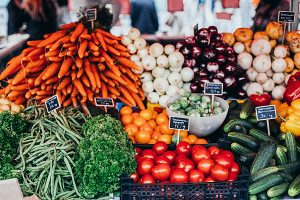
This is a vegetable marrow with the alternative name, courgette.
Zucchini is yet another fruit veggie with mediocre levels of minerals and vitamins. Its very modest attributes are useful contents of potassium, calcium, carotenoids, vitamin C (24 mg per 100 gm) and folate (60 micrograms).
For the home gardener, this is the fastest growing veggie of all, and needs to be picked before it becomes the size of a marrow. It can be eaten grated raw or lightly steamed.
Squash, Marrow
There is nothing in these similar veggies to get excited about. Their minerals and vitamins are at low-ish levels, except for a modest amount of vitamin C in squash (26 mg). They might add a touch of pleasant tasting bulk to a meal or be useful in recipes.
Eggplant
Eggplant – or aubergine in the US – is the veggie that is hapless for flavour, but loaded with a super antioxidant.
Although almost flavourless, eggplant is worth doctoring with other flavours because of its high levels of anthocyanins and proanthocyanidins – antioxidants far more powerful than vitamin C. These give the black colour, so the skin needs to be consumed to obtain the benefits.
The only other nutrients worth mentioning are high levels of chlorine and sulphur. The chlorine promotes skin health, cleanses the blood and facilitates stomach acid production. The sulphur further enhances the skin.
Rather than frying eggplant which allows a lot of oil to be absorbed, this veggie can be baked or grilled. To grill, cut into slices, smear with oil, add whatever other flavours or condiments you want and grill. Many recipes make eggplant tasty by additions such as herbs, garlic, tomato, cheese, lemon juice, sea salt, pepper, butter or oil.
STEM VEGETABLES
Celery
Celery is the classic stem veggie that could be in every salad and vegetable juice. It is high in potassium and one of the richest veggies in sodium (organic as distinct from the inorganic sodium in table salt).
Celery contains excellent levels of chlorine, sulphur, silicon and bromine and useful levels of lutein and zeaxanthin for the eyes
A number of novel phytonutrients have allowed celery to be used therapeutically for centuries. The juice has been used for urinary tract infections; its phthalides lower high blood pressure, are diuretic and have tranquillising effects; its alkalinity helps rheumatoid arthritis; it thins the blood and opposes strokes; the phytochemicals acetylenic and phenolic acids inhibit the growth of cancer cells; and inflammatory prostaglandins are reduced. Raw celery consumed on hot days replaces the lost sodium and other minerals and protects against the resulting cramps.
Celery is a mighty good veggie. Home grown, it can be bitter, so the commercial growers wrap the stems in paper two weeks prior to harvest to exclude sunlight and blanch them, which eliminates the bitterness, but also reduces the nutritional value.
Asparagus
Regarded as a gourmet veggie, asparagus has quite a number of beneficial constituents. The most prominent is an alkaloid, asparagine, which helps to relieve various kidney and bladder problems. Asparagine combined with a rich potassium content has a diuretic effect, which is beneficial for fluid retention and high blood pressure. As a preventative to the latter, asparagus could be eaten regularly.
But limit intake of asparagus to no more than 50 to 100 gm daily, otherwise the kidneys could be irritated.
Similarly to celery, asparagus has high levels of chlorine, sulphur and silicon. Again, because chlorine and sulphur are destroyed by heat, the asparagus needs to be eaten raw. There is plenty of folate (120 micrograms) and good supplies of the compounds, glutathione, which is anti-cancer, and rutin which strengthens blood capillaries.
ROOT VEGETABLES
Carrot
The bright orange colour of this extremely popular veggie is due to carotenes, which are just a few of the 600-odd member carotenoid family. Recently a purple variety has been appearing in shops. Not only do purple carrots contain all the phytochemicals found in orange carrots, they also contain the potent antioxidants, anthocyanins.
Carrots have a huge content of beta-carotene, alpha-carotene and cryptoxanthin, their beta-carotene equivalent being 10,350 micrograms, which is many times that of any other vegetable or fruit. Our bodies convert these to vitamin A, which is needed for vision – so carrots do help us see in the dark! Studies have found that high intakes of carotenoids significantly reduce the risk of cancer, including cancers of the cervix, lungs and stomach.
Other attributes of carotenes and vitamin A are that they strengthen immunity, promote wound healing, help to reduce blood pressure, help detox the liver, strengthen mucous membranes and enable the skin to resist sun damage.
Good contents of chlorine, sulphur and silicon enhance liver cleansing and skin condition.
It is possible to consume too many carrots, especially if they are juiced. Some people have unwittingly drunk the juice of many kilos of carrots daily. If the body cannot keep up with metabolising the beta-carotene, it builds up in the blood and skin, giving the skin a characteristic yellow colour, known as carotenaemia. Fortunately, if the intake is stopped promptly, the excess clears away, usually without having caused harm.
Beetroot
That deep red colour of beetroot indicates something special. It is a popular misconception that the colour is due to anthocyanins, the powerful antioxidant in red cabbage and eggplant. In fact, the colour is due to the purple pigment betacyanin and a yellow one betaxanthin, known collectively as betalins. Betacyanin is a cancer-fighting agent, especially against colon cancer, and beetroot extract has been found to inhibit the growth of tumours. This may explain why a medical doctor many years ago was treating cancer with beetroot and its juice.
Another phytochemical, betaine, richly supplied in beetroot, lowers homocysteine levels, thereby reducing the risk of atherosclerosis, heart disease and blood clots.
Raw beetroot is also rich in folates, with 109 mcg per 100 gm, which further reduces heart risk.
There are good levels of potassium and sodium, along with 8% sugar content, providing a light sweetness.
A juice made from beetroot, carrot and green veggies is a great blood purifier and detoxifier. Cooked and canned beetroot does not provide all these benefits.
Turnip, Swede (Brassica group)
Turnips and Swedes are very similar, both being Brassicas. It appears that the Swede or Swede turnip was originally a cross between turnip and cabbage.
Neither has much to offer nutritionally, other than a good dose of potassium. Other minerals are low to mediocre. Both are low-calorie, filling foods, and if you like their flavours, that’s fine.
Parsnip
This veggie has more to offer than the turnip. It contains quite a high potassium level and useful calcium. It is rich in silicon for the skin, hair and nails and sulphur and chlorine for cleansing the system.
Carbohydrate is high-ish at 10%, being roughly equal quantities of starch and sugar.
Radish
The strong flavour is due to high chlorine and sulphur contents. The (organic) chlorine facilitates stomach acid production and is beneficial for mucus conditions.
MISCELLANEOUS
Sprouted seeds and grains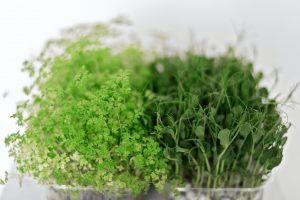
Sprouts are a vegetable that will grow in any climate (preferably indoors), may be planted any day of the year, require neither soil nor sunshine, mature in three to seven days and are exceptionally nutritious. They are outstanding foods. Popular sprouts are alfalfa (the leader), mung bean, lentil and soya bean, although the variety of sprouts available continues to grow. You can purchase a variety of sprout growing kits with excellent reliability here (affiliate link), they even stock pink kale kits – YUM!
In addition to manufacturing large quantities of vitamins, particularly C and folic acid, and carotenoids, the sprouting process converts starches to simple sugars, making sprouts easy to digest. In fact, all the major nutrients are partially digested, making sprouts very eater-friendly.
Even more eater-friendly is the fact that the germination process destroys ‘anti-nutritional’ factors in the seeds, the prominent ones being enzyme inhibitors and phytic acid in legumes.
Alfalfa sprouts have high antioxidant activity against free radicals. They are also the richest food source of the phytoestrogens, isoflavones, which have an important role in prevention of menopausal symptoms, osteoporosis, cancer and heart disease.
These sprouts are about 3% protein. They are abundant in dietary fibre (3%), and contain useful levels of vitamins C, K, B1, B2, B5 and folate and carotenoids and the minerals magnesium, calcium, zinc, copper, manganese and iron. The nutritional value of alfalfa sprouts makes them ideal for weight loss and maintaining plain good health
They have a great texture for use in salads, sandwiches and omelettes.
Lentil, mung and soya bean sprouts. Their easily digested protein contents are 10%, 3% and 13% respectively, which are outstanding for water-rich foods.
These bean sprouts are great sources of vitamin C and useful sources of the B-vitamins, B1, B2, B3, B5, B6 and folate, the last of these being very richly supplied.
Bean sprouts have a significant mineral content, similar to alfalfa in kind. The levels of manganese in lentil and soya sprouts are very high. Mung sprouts tend to be lower in minerals, but higher in vitamin K.
The essential fatty acids – omega-3 and omega-6 – are well supplied in soya sprouts and at modest levels in the other two.
Green peas
Being a legume (which means they extract nitrogen from the atmosphere to make protein), they are rich in protein for a veggie at 6%. And being an immature seed, they are relatively rich in most nutrients. Fibre is 5.6% and sugar is 4% which is why they are subtly sweet.
Outstanding minerals and vitamins are iron (1.8 mg), zinc, copper, folate, B-vitamins and vitamin C (32 mg). Peas are a very nutritious veggie, even better if eaten raw.
Green beans
Also a legume, green beans – or French beans or string beans – are somewhat like a scaled down version of green peas, reflecting their much lower content of seeds. The amounts of most nutrients are considerably lower than in peas, except for higher calcium (42 mg). The calories supplied are one-third that of peas.
Nevertheless, green beans are quite nutritious. If they are young and succulent, try them raw.
Broad beans
Some of us love ‘em and some hate ‘em. Again as a legume, they are very high in protein, at 7%, compared to other veggies, and also very high in fibre at 6%.
Their other notable features are high iron at 1.9 mg per 100 gm, good magnesium at 30 mg and very good vitamin C at 41 mg.
Mushrooms
Not a vegetable, but a fungus. Nevertheless, the nutrition of mushrooms is akin to many veggies and offers unique benefits.
There are about a dozen varieties of mushrooms available commercially. The reishi and shiitake varieties have anti-cancer properties, so much so for the shiitake that in Japan its extract is registered as a drug to treat cancer. Mushrooms in general support the immune system and are anti-viral, anti-inflammatory and antioxidant.
Minerals and vitamins are low, except for potassium which is high and vitamins B1, B2 and B3 which are at excellent levels. If vitamin B12 is present, it is likely to be an inactive analogue, so mushrooms are not a reliable source of B12. Mushrooms contain good levels of the amino acid, lysine.
If you like mushies, enjoy them, but perhaps don’t overdo them as we humans are not essentially fungus eaters.
Garlic
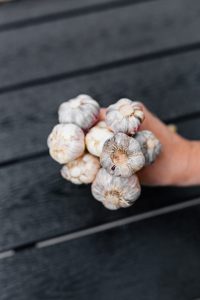
Garlic is in the plant genus, Allium, along with onions, shallots, Spring onions, leeks and chives. Garlic and onions share numerous properties. They have a unique defence system against pests that include bacteria, grazing animals and humans with chopping knives. Alliin, an amino acid based on cysteine, is converted into allicin at the instant that the garlic tissue is injured. Allicin is the distinctively pungent substance in garlic that deters pests and provides many of its healing benefits. In onions, there are alliin plus other compounds that work in the same way to deter pests.
Garlic has a long history of use as food and in traditional medicine. It exhibits anti-bacterial, anti-viral and anti-fungal properties, has long been known to strengthen the immune system and protect against colds and flu. It helps lower blood pressure and reduces the formation of blood clots. Allicin, along with a sulphur compound and other antioxidant compounds, neutralises free radicals and so helps to protect against heart disease, cancer and premature ageing. Regularly eating garlic has been found to lower the risk of stomach cancer.
Garlic is well known to protect against intestinal worms. Give some to your dog as well for worm protection.
Garlic truly is a wonder food, but don’t have too much. One clove a day is about right for its therapeutic benefits, but five cloves daily on a regular basis has been found to cause harm, for example, irritation to the digestive tract, in addition to unfriendly garlic breath and body odour.
Raw garlic provides the most benefits, but deodorised tablets, etc, still have plenty to offer.
Onions
When an onion is injured, a compound slightly different from allicin is formed; this one is still pungent, but causes us to ‘cry’ when we cut or peel an onion. It is the flavour of onions that makes them popular in recipes.
Similarly to garlic, onions are a home remedy for colds, coughs and bronchitis and have many other therapeutic properties. Onions are beneficial to the respiratory system as a whole and support the friendly bacteria in the intestine.
Onions also contain higher concentrations of the flavonoid, quercetin, than any other fruit or vegetable. Quercetin is a powerful antioxidant. Red onions contain, in addition, the super powerful antioxidants, anthocyanins, which provide the red colour. These antioxidants make onions significantly protective against heart disease and cancer. Quercetin is also anti-inflammatory and anti-diabetes and is a phytoestrogen.
Raw onion in a salad is the best way to eat it. Roasted or baked is fine, but avoid frying with all that fat – unless it is coconut oil, which is highly resistant to rancidity.
Leeks
These are the plain members of the onion family, but have a few special benefits. They contain good levels of beta-carotene, lutein and zeaxanthin, which onions don’t. These nutrients are needed by the eyes to prevent macular degeneration, as well as being antioxidants.
Leeks prevent blood clots forming and may even dissolve them. They are a good source of sulphur with its anti-bacterial properties.
Chives
Garlic chives, also called Chinese chives or Oriental chives, are good as a mild substitute for garlic.
Ginger
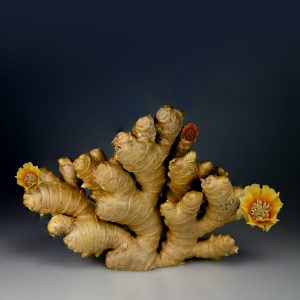 Ginger, which is not a root, but a horizontal stem, is notable for its pungent gingerols, which are anti-inflammatory and reduce the damage caused by free radicals.
Ginger, which is not a root, but a horizontal stem, is notable for its pungent gingerols, which are anti-inflammatory and reduce the damage caused by free radicals.
Ginger is prominent for its effectiveness as a digestive aid. By increasing the production of digestive fluids, it helps relieve indigestion, bloating, diarrhoea and stomach cramps. By promoting sweating, ginger helps to detoxify the system.
As a natural anti-motion-sickness remedy, ginger is popular for relieving car sickness and sea sickness.
Roger French, NHSA Patron.
Originally published in True Natural Health
